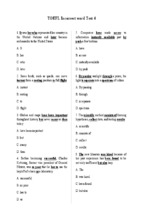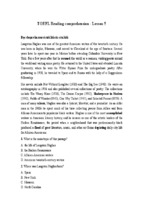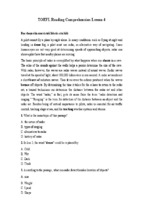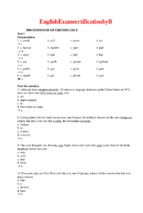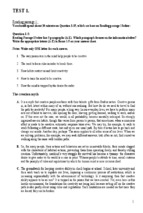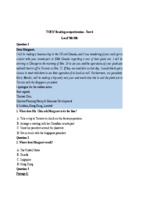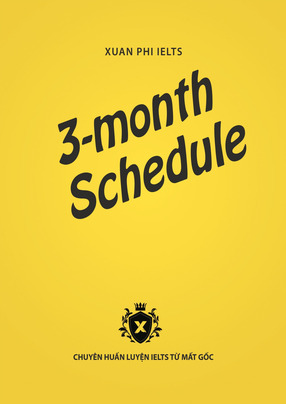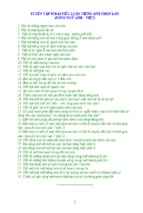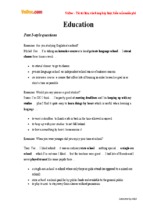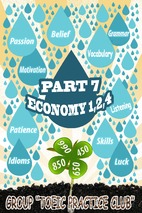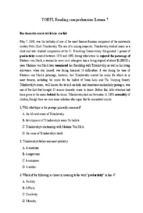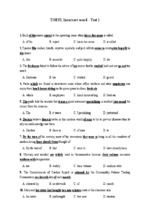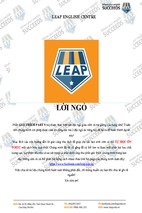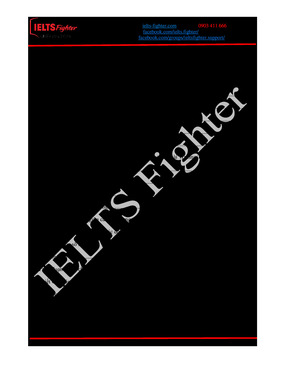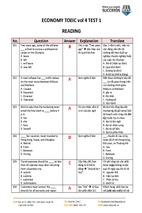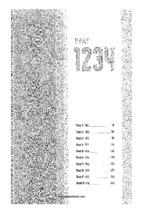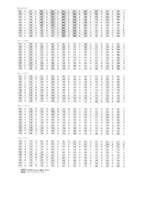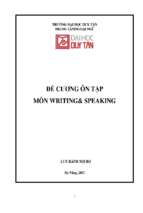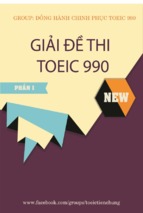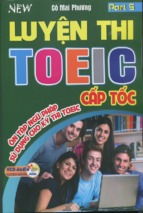ZIM School of English and
Test Preparation
Giới thiệu
IELTS Wring 2019 Review là ấn phẩm được đội ngũ chuyên gia luyện thi IELTS tại Anh
Ngữ ZIM biên soạn với mục đích giúp người học có cái nhìn vừa tổng quan vừa chi ết
về độ khó của đề thi IELTS Wring trong cả năm 2019. Đồng thời, tài liệu cũng cung cấp
nhiều phương án xử lý các đề thi cụ thể qua việc phân ch đề, lập dàn ý và bài mẫu tham
khảo. Nội dung chính của sách bao gồm:
• Tổng
Tổng hợp đề thi thật IELTS Wring
Wring (hình thức thi trên giấy) trong năm 2019
• Phân ch đề bài
• Gợi ý các hướng triển khai idea và lập dàn bài
• Bài mẫu tham khảo Band điểm 7+
• Phân ch từ vựng hay và cấu trúc câu nổi bật trong bài
IELTS Wring 2019 Review là sản phẩm trí tuệ của đội ngũ chuyên gia tại Anh Ngữ
ZIM. Các hành vi sao chép dưới mọi hình thức mà không có sự đồng ý bằng văn bản từ
phía Anh Ngữ ZIM đều là những hành vi vi phạm bản quyền và luật sở hữu trí tuệ.
Hướng dẫn sử dụng sách
Để sử dụng tài liệu đạt hiệu quả cao nhất, người đọc nên tuân theo các bước làm bài
sau:
BƯỚC 1
Đọc kỹ phần phân ch đề bài để hiểu rõ các
thông n trong đề và những yêu cầu cần trả
lời trong bài viết.
BƯỚC 2
Tham khảo những gợi ý có thể dùng cho bài và
chọn những ý mà dễ để viết với vốn kiến thức
xã hội và kỹ năng ếng Anh của cá nhân mình.
BƯỚC 3
Chọn 1 trong các hướng triển khai bài đã được
gợi ý trong sách (nên chọn hướng đi giống bài
mẫu ở sau) và luyện viết 1 bài đầy đủ.
BƯỚC 4
Đọc tham khảo bài mẫu để học hỏi cách sử
dụng từ và cách diễn đạt ý sao cho rõ ràng và
mạch lạc và sửa vào bài viết của mình.
Mục lục
IELTS Wring Actual Test 05/01/2019 ....................................................................... 8
IELTS Wring Actual Test 12/01/2019 ..................................................................... 15
IELTS Wring Actual Test 17/01/2019 ..................................................................... 21
IELTS Wring Actual Test 19/01/2019 ..................................................................... 27
IELTS Wring Actual Test 02/02/2019 ..................................................................... 33
IELTS Wring Actual Test 09/02/2019 ..................................................................... 41
IELTS Wring Actual Test 14/02/2019 ..................................................................... 47
IELTS Wring Actual Test 23/02/2019 ..................................................................... 54
IELTS Wring Actual Test 02/03/2019 ..................................................................... 61
IELTS Wring Actual Test 09/03/2019 ..................................................................... 69
IELTS Wring Actual Test 14/03/2019 ..................................................................... 77
IELTS Wring Actual Test 23/03/2019 ..................................................................... 84
IELTS Wring Actual Test 06/04/2019 ..................................................................... 91
IELTS Wring Actual Test 13/04/2019 ..................................................................... 98
IELTS Wring Actual Test 25/04/2019 ................................................................... 106
IELTS Wring Actual Test 27/04/2019 ................................................................... 113
IELTS Wring Actual Test 04/05/2019 ................................................................... 120
IELTS Wring Actual Test 11/05/2019 ................................................................... 126
IELTS Wring Actual Test 18/05/2019 ................................................................... 132
IELTS Wring Actual Test 23/05/2019 ................................................................... 138
IELTS Wring Actual Test 01/06/2019 ................................................................... 145
IELTS Wring Actual Test 13/06/2019 ................................................................... 150
IELTS Wring Actual Test 22/06/2019 ................................................................... 160
IELTS Wring Actual Test 29/06/2019 ................................................................... 168
IELTS Wring Actual Test 06/07/2019 ................................................................... 176
IELTS Wring Actual Test 18/07/2019 ................................................................... 183
IELTS Wring Actual Test 20/07/2019 ................................................................... 190
IELTS Wring Actual Test 27/07/2019 ................................................................... 197
IELTS Wring Actual Test 01/08/2019 ................................................................... 203
IELTS Wring Actual Test 10/08/2019 ................................................................... 211
IELTS Wring Actual Test 17/08/2019 ................................................................... 219
IELTS Wring Actual Test 24/08/2019 ................................................................... 226
IELTS Wring Actual Test 07/09/2019 ................................................................... 233
IELTS Wring Actual Test 12/09/2019 ................................................................... 240
IELTS Wring Actual Test 14/09/2019 ................................................................... 248
IELTS Wring Actual Test 28/09/2019 ................................................................... 255
IELTS Wring Actual Test 10/10/2019 ................................................................... 262
IELTS Wring Actual Test 12/10/2019 ................................................................... 269
IELTS Wring Actual Test 19/10/2019 ................................................................... 276
IELTS Wring Actual Test 26/10/2019 ................................................................... 283
IELTS Wring Actual Test 02/11/2019 ................................................................... 290
IELTS Wring Actual Test 07/11/2019 ................................................................... 296
IELTS Wring Actual Test 16/11/2019 ................................................................... 304
IELTS Wring Actual Test 23/11/2019 ................................................................... 312
IELTS Wring Actual Test 30/11/2019 ................................................................... 320
IELTS Wring Actual Test 07/12/2019 ................................................................... 326
IELTS Wring Actual Test 12/12/2019 ................................................................... 335
IELTS Wring Actual Test 14/12/2019 ................................................................... 342
Phụ Lục .......................................................................................................................... 349
12/01
02
02
Animal products
Phân ch
1. In the modern world, it is no longer necessary to use animals as food or other products,
such as medicines and clothing. Do you agree or disagree? (Đề thi ngày 05/01/2019)
Yêu cầu: đưa ra ý kiến về việc con người có thực sự cần sử dụng động vật để sản xuất
thực phẩm và các mặt hàng khác hay không.
2. A growing number of people feel that animals should not be exploited by people and that
they should have the same rights as humans, while others argue that humans must employ
animals to sasfy their various needs, including uses for food and research.
Discuss both views and give your opinion.
3. Nowadays animal experiments are widely used to develop new medicines and to test
the safety of other products. Some people argue that these experiments should be banned
because it is morally wrong to cause animals to suer, while others are in favor of them
because of their benets to humanity. Discuss both views and give your own opinion.
Câu hỏi 2 và 3 yêu cầu: đưa ra ý kiến tại sao một số người nghĩ rằng việc sử dụng động
vật để phục vụ nhu cầu của con người là cần thiết và tại sao những người khác lại cho
rằng động vật có quyền bình đẳng với con người.
Dưới đây là cách ếp cận cho câu hỏi thứ nhất.
Dàn ý
Introducon
Mở bài giới thiệu chủ đề và đưa ra ý
kiến cá nhân đồng ý với quan điểm
đưa ra ở đề bài.
Step
01
Body 1
Step
02
Đoạn thân bài thứ nhất bàn luận
rằng ăn thịt động vật nhiều sẽ gây
ra nhiều bệnh tật cũng như có nhiều
loại thực phẩm thay thế khác.
Body 2
Đoạn thân bài thứ hai khẳng định
việc sử dụng động vật để làm thuốc
không được xã hội ủng hộ và có
nhiều loại thuốc làm từ thực vật có
tác dụng chữa bệnh tốt hơn. Thêm
vào đó chúng ta cũng không cần
phụ thuộc vào động vật để sản xuất
quần áo nữa.
Step
03
Step Conclusion
04
Kết bài khẳng định và tóm tắt lại đại
ý của toàn bài viết.
Bài mẫu tham khảo
The argument over the use of animals to provide food, medicine, and clothing has been
ongoing for years. Some people consider the killing of animals to produce food and
other products to be unnecessary. In my view, I agree with this idea and will discuss
several compelling reasons in this essay.
These days, we are faced with many public health challenges regarding poor health
condions, including cancer and heart disease, caused by excessive consumpon of
meat on a regular and long-term basis.(1) Experts are calling for a change in human diets
so that people can enjoy beer health. Fortunately, many alternave meat products are
available on the market. In fact, vegetarian diets are being favored by a growing number
of people and can provide the same amount of nutrients for consumers. In parcular,
mushrooms and tofu contain high levels of protein, a kind of nutrient presumably only
found in meat, and can therefore be used as a substute.(2)
Furthermore, medical experiments on animals and medicines manufactured from
animals’ body parts received lile endorsement in the past. Nowadays, herbs and many
other types of plant-based medicines, such as ginseng, can cure many diseases, prolong
human life expectancy, and aid medical praconers in the treatment of many illnesses.
More seriously, thousands of wild animals, such as gers and minks, are killed each
year, with their fur taken to produce coats and accessories for the fashion industry.(3)
There are now similar products made from plants and arcial materials that can fulll
our needs. Animals do not have to suer for our needs anymore.
In conclusion, I think that our needs and desires do not jusfy the suering of animals
and animal products are no longer necessary. We can choose a dierent source of
nourishment, medicine and clothing without any toll on wild animals.
If something takes its/a toll, it causes suffering,
deaths, or damage
Band điểm 7.0+
4. New born infant: trẻ sơ sinh
5. Adolescence: giai đoạn thanh thiếu niên
6. An innate skill: một kĩ năng bẩm sinh
7. Their own upbringing: quá trình nuôi dưỡng
8. Cultural inuences: những ảnh hưởng về văn hoá
Cấu trúc câu
Câu (1): Similarly, many parents have a great deal of trouble dealing with troublesome
teenagers who are misbehaving while going through adolescence.
Cấu trúc cần lưu ý:
• Cụm động từ “deal with” đồng nghĩa với “handle”, or “solve something ”, nghĩa là giải quyết
vấn đề gì đó.
• Cụm động từ “ go through” đồng nghĩa với “experience something ”, nghĩa là trải qua điều
gì.
• Liên trạng từ “similarly ” được dùng khi người viết muốn đưa thêm ý tưởng tương tự ý
tưởng có từ trước.
Câu (2): However, while parenng courses could provide a lot of good skills and
informaon for parents, many people would argue that parenng is an innate skill that
every mother and father can naturally access once they have a child.
Cấu trúc cần lưu ý:
• Liên trạng từ “however ” được dùng khi người viết muốn nhấn mạnh sự đối lập giữa hai
ý tưởng.
• Cấu trúc “providing something for somebody ” đồng nghĩa với to “ give something to
someone”. Hoặc người viết có thể sử dụng cấu trúc “provide somebody with something ”
với cùng nghĩa đó.
Câu (3): Lastly, many people would consider it ridiculous that people should be forced
to aend parenng courses as people should be free to make their own decisions.
Cấu trúc cần lưu ý:
• Từ “ridiculous” nghĩa là nực cười.
• Từ “as” đồng nghĩa với từ “because”.
• “Be forced to do something ” đồng nghĩa với “being made to do something dicult or
unpleasant”, nghĩa là bị ép buộc làm gì.
12/01
09
02
The table below shows expenditures on adversing of four car companies in the UK
in 2002.
Dàn bài
Mở bài: Viết lại câu hỏi theo cách khác.
Đoạn tổng quan: Phân ch các đặc điểm chính.
Gợi ý:
• Renault êu nhiều ền nhất vào quảng cáo.
• Quảng cáo trên TV là hình thức quảng cáo thịnh hành nhất.
Đoạn miêu tả 1: So sánh các số liệu cho 2 loại quảng cáo (tập trung vào số liệu lớn nhất
và nhỏ nhất).
• Quảng cáo trên TV.
• Quảng cáo qua báo chí (press adversing).
Đoạn miêu tả 2: So sánh các số liệu cho các loại quảng cáo còn lại.
Bài mẫu tham khảo
The table shows the amount of money that four car manufacturing companies spent on
dierent forms of adversing in the UK in 2002.
It is clear that Renault spent the largest amount of money on adversing during 2002. In
addion, TV adversements were by far the most popular adversing format while the
opposite was true for cinema adversing.
In 2002, Cerizine allocated $70 million for TV adversements while the gure for
Vauxhall was slightly lower, at $65 million. Meanwhile, $59 million was spent on TV
commercials by Renault, and only $45 million by Rover. In terms of press adversing, the
amount of money spent by Renault was again largest, at $45 million, slightly higher than
that of Rover, at $38 million. In contrast, Vauxhall and Cerizine only spent $8 million
and $12 million on press adversing, respecvely.
Of the other forms, adversing in cinemas and outdoors incurred the lowest costs, with
less than $10 million spent by each company. It is also notable that expenditure on radio
adversing by all car manufacturers was similar, at $15 million each.
Band điểm 7.0+
12/01
14
02
Road safety
Phân ch
Một số câu hỏi liên quan đến chủ đề này:
1. Some people think that the best way to improve road safety is to increase the minimum
legal age for driving a car or motorbike.
To what extent do you agree or disagree? (Đề thi ngày 17/01/2019)
2. The only way to improve safety of our roads is to give much stricter punishments on driving
oenses.
To what extent do you agree or disagree?
3. Some people think that strict punishments for driving oences are the key to reducing
trac accidents. Others, however, believe that other measures would be more eecve in
improving road safety.
Discuss both these views and give your own opinion.
Dưới đây là cách ếp cận câu hỏi thứ nhất.
12/01
14
02
Museums
Phân ch
Chủ đề này đã xuất hiện nhiều trong kỳ thi IELTS, người viết thường được hỏi về lợi ích
và bất lợi cũng như vai trò của bảo tàng hay khu di ch lịch sử trong xã hội hiện đại ngày
nay. Một số đề thuộc chủ đề Museums
Museums như:
như:
1. Some people claim that public museums and art galleries will be no longer necessary
because people can see historical objects and works of art by using a computer.
Do you agree or disagree?
disa gree? (Đề thi ngày 14/02/2019)
Yêu cầu: người viết so sánh giữa “public museums and art galleries” với “seeing historical
objects and works of art by using a computer”.
computer”.
2. Some people think that museums should be enjoyable places to entertain people, while
others believe that the purpose of museums is to educate.
Discuss both views and give your own opinion.
Yêu cầu: người viết đưa ra lý do cho hai quan điểm: tại sao bảo tàng lại là nơi thư giãn
và là nơi giáo dục.
Dưới đây là cách ếp cận đối với đề thứ nhất.
Dàn ý
Introducon
Mở bài giới thiệu chủ đề và nêu ra ý
kiến cá nhân không đồng ý với quan
điểm nêu ra ở đề bài.
Step
01
Step
02
Body 1
Đoạn thân bài thứ nhất đưa ra lý do
tại sao nhiều người lại nghĩ bảo tàng
và triển lãm nghệ thuật không còn
cần thiết sau đó đưa ra ý kiến phản
biện.
Body 2
Đoạn thứ hai đưa ra lý do tại sao bảo
tàng và triển lãm nghệ thuật vẫn còn
cần thiết vì du khách đến để chiêm
ngưỡng cả kiến trúc của những nơi
này.
Step
03
Step
04
Conclusion
Kết bài tóm tắt lại đại ý chung của
toàn bài và nêu rõ lại quan điểm cá
nhân.
Bài mẫu tham khảo
In current mes, we can read about and view images of arscally, culturally and
historically signicant works from anywhere with an internet connecon. Some people
believe that the advent of the internet has made the existence of art galleries and public
museums obsolete. I personally disagree, and my view will be explained in this essay.
The internet has brought us the ability to search for informaon and images about most
things we consider to be historically or culturally signicant.(1) This informaon can be
found by using search engines
engi nes like Google;
Goog le; video streaming
s treaming sites
si tes like You
YouT
Tube; or regular
regu lar
informaon websites such as Wikipedia. Some people claim that to obtain informaon
about art, history or culture through
culture through one of these channels provides us with sucient
understanding of that
of that parcular topic.(2) Therefore, we no longer need museums and
galleries. However, I believe the informaon regarding an object is dierent from the
experience of being in the presence of the object itself. This experience is unique and
should be preserved.
Furthermore, the designs of museums and art galleries are usually based on a country’s
Furthermore,
architectural style. People can enjoy viewing
viewing art works and arfacts and learning about
the history and art of the country they are vising
vising while admiring the grandeur of these
places.(3) Millions of people visit The Louvre Museum every year not just because it
exhibits a huge collecon of priceless naonal masterpieces but also because it is a
prime example of the
of the aesthec appeal of French architecture.(4)
Informaon about almost any work
work of art or historical object can be found on the internet
today. However, the experience of knowing about something and the experience of
being in the presence of that thing are two dierent ideas. I believe both of them are
important and therefore museums and galleries are sll needed.
Band điểm 7.0+
Từ vựng
1. To obtain informaon about art, history or culture: lấy thông n về nghệ thuật, lịch
sử và văn hóa
2. T
To
o provide us with sucient understanding of something: cung cấp cho chúng ta đủ
sự hiểu biết về cái gì đó
3. To be in the presence of something: tận mắt chiêm ngưỡng
4. A country’s architectural style: phong cách kiến trúc của một quốc gia phản ánh văn
hóa và lịch sử quốc gia đó
5. To admire the grandeur of these places: ngắm nhìn sự trang nghiêm oai vệ của những
địa điểm này
6. To exhibit a huge collecon of priceless naonal masterpieces: trưng bày một bộ sưu
tầm khổng lồ các kiệt tác của quốc gia
7. The aesthec appeal of French architecture: sức hấp dẫn về mặt thẩm mỹ của kiến
trúc nước Pháp
Cấu trúc câu
Câu (1): The Internet has brought us the ability to search for informaon and images
about most things we consider to be historically or culturally signicant.
Cấu trúc cần lưu ý:
signicant” là mệnh đề quan hệ bổ
• Mệnh đề “we consider to be historically or culturally signicant”
sung thông n cho danh từ “most
“most things”
things”.
• Cấu trúc “bring
“bring somebody something ” mang nghĩa mang đến cho ai đấy điều gì đó.
• Cấu trúc “consider
“consider something to be + adjecve”
adjecve” mang nghĩa coi rằng hoặc cho rằng thứ
gì như thế nào.
Câu (2): Some people claim that to obtain informaon about art, history or culture
through one of these channels provides us with sucient understanding of that
parcular topic.
Cấu trúc cần lưu ý:
• Cấu trúc “some
“some people claim that”
that” được sử dụng để đưa ra quan điểm của mọi người về
một vấn đề gì đó.
• Cấu trúc “provide
“provide somebody with something ” đồng nghĩa với “ give
“ give something to somebody ”,
mang nghĩa cung cấp cho ai đó cái gì.
Câu (3): People can enjoy viewing
viewing art works and arfacts
a rfacts and learning about the history
and art of the country they are vising while admiring the grandeur of these places.
Cấu trúc cần lưu ý:
• Mệnh đề “they
“they are vising ” là mệnh đề quan hệ (thể rút gọn) bổ nghĩa cho danh từ “the
“the
country ”.
Câu (4): Millions of people visit The Louvre Museum every year not just because it
exhibits a huge collecon of priceless naonal masterpieces but also because it is a
prime example of the aesthec appeal of French architecture.
Cấu trúc cần lưu ý:
• Cấu trúc “not
“not only … but also …”
…” mang nghĩa không chỉ (“not only”) đúng đối với cái này
mà còn (“but also”) đúng với cái khác nữa.
12/01
14
02
The table below presents the food consumpon per a person weekly in a European
country in 1992, 2002 and 2012.
590
Phân ch
Dạng bài: Table
Đối tượng đề cập trong bài: Sự êu thụ 5 loại đồ ăn khác nhau.
Đơn vị đo lường: Grams
Thì sử dụng: Khoảng thời gian được đưa ra là vào ba năm 1992, 2002 và 2012 nên
chúng ta sẽ dùng thì quá khứ đơn trong bài viết.
Dàn bài
Mở bài: Viết lại câu hỏi theo cách khác.
Đoạn tổng quan:
• Vegetables
Vegetables được êu thụ nhiều nhất trong cả 3 năm, trong khi số liệu của Cheese thấp
nhất.
• Lượng êu thụ tất cả các loại đồ ăn có xu hướng giữ ổn định trong 3 năm.
Vegetables và Meat.
Đoạn miêu tả 1: Miêu tả số liệu, xu hướng của hai loại đồ ăn: Vegetables
- Xem thêm -

